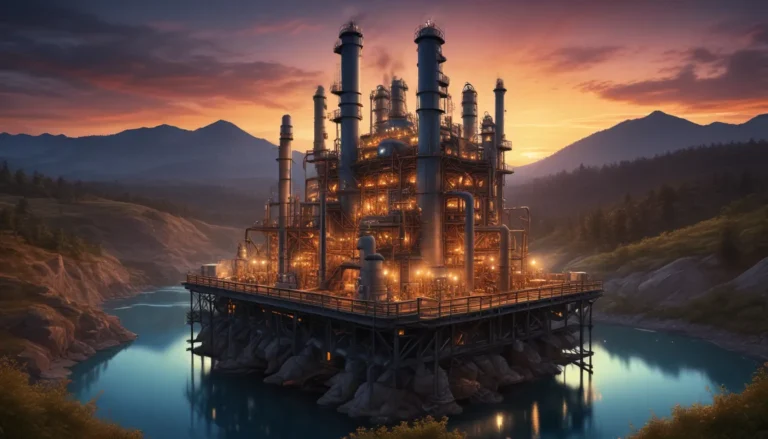A Note About Images: The images used in our articles are for illustration purposes only and may not exactly match the content. They are meant to engage readers, but the text should be relied upon for accurate information.
Radioactive decay, a mesmerizing phenomenon that weaves through the realms of chemistry, physics, and geology, is a process that holds the key to a myriad of scientific discoveries and practical applications. Delving into the depths of radioactive decay unravels a world of nuclear transformations that shape our understanding of the universe. From its role in dating techniques to its impact on energy production, radioactive decay is a cornerstone of modern science. Join us on an enlightening journey as we explore 18 captivating facts about radioactive decay, shedding light on its mechanisms, significance, and real-world implications.
Unveiling the World of Radioactive Decay
Radioactive decay is a natural process that occurs in certain elements, leading to the release of radiation and the formation of different elements. Understanding this intricate process is not only crucial for academic purposes but also has practical applications in fields like medicine and energy production. Let’s embark on a journey to uncover the mysteries of radioactive decay and its profound influence on the world around us.
The Fundamentals of Radioactive Decay
-
A Natural Process: Radioactive decay is a spontaneous process in which an unstable atomic nucleus loses energy by emitting radiation. This process is entirely random and cannot be influenced by external factors.
-
Isotopes and Decay: Radioactive decay occurs in isotopes of elements, which are variants of a chemical element with the same number of protons but different numbers of neutrons. This process leads to the formation of different elements and the release of radiation.
-
Types of Decay: There are three primary types of radioactive decay – alpha decay, beta decay, and gamma decay. Each type involves the release of different particles and energy, resulting in the transformation of the original nucleus.
Exploring the Implications of Radioactive Decay
-
Measuring Decay: The concept of half-life is pivotal in understanding radioactive decay. It represents the time required for half of the radioactive nuclei in a sample to undergo decay, providing insights into the stability and decay rate of a radioactive substance.
-
Radiometric Dating: Radioactive decay plays a vital role in radiometric dating, allowing scientists to determine the age of materials such as rocks and fossils. This technique is instrumental in unraveling the mysteries of the Earth’s history.
-
Practical Applications: The applications of radioactive decay are diverse and far-reaching. From medical imaging to power generation in nuclear reactors and environmental monitoring, radioactive decay serves as a cornerstone in various fields.
Unveiling the Intricacies of Radioactivity
-
Unstable Elements: Some elements, such as technetium and promethium, do not have stable isotopes and undergo radioactive decay. These elements are either produced artificially or occur as by-products of nuclear reactions.
-
Nuclear Physics: Radioactive decay is a fundamental concept in nuclear physics, governing the behavior of atomic nuclei and the release of energy in nuclear reactions. This knowledge forms the foundation of nuclear power and weaponry.
-
Hazardous Effects: Exposure to high levels of radioactive decay products can be harmful to living organisms, leading to genetic mutations, radiation sickness, and an increased risk of cancer. Proper safety measures are imperative when working with radioactive materials.
Embracing the Influence of Radioactive Decay
-
Background Radiation: Natural background radiation, stemming from sources like radon gas and cosmic rays, is a constant presence in the environment. This radiation contributes to overall human exposure levels.
-
Shielding Against Radiation: Various materials, such as lead and concrete, are effective in shielding against the radiation emitted during radioactive decay. This principle is integral in designing protective barriers for nuclear facilities and equipment.
-
Continuous Process: Radioactive decay occurs at a constant and predictable rate, allowing scientists to study the behavior of radioactive isotopes over time. This process remains unaffected by changes in temperature, pressure, or chemical reactions.
Unraveling Nuclear Transmutation and Artificial Decay
-
Nuclear Transmutation: During radioactive decay, the original nucleus undergoes transmutation, leading to the formation of a different element. This transformation is a fundamental concept in nuclear chemistry and particle physics.
-
Artificial Induction: Artificially induced radioactive decay finds applications in medical treatments and scientific research. By bombarding stable nuclei with particles, scientists can create radioactive isotopes for specific purposes.
-
Source of Geothermal Heat: The decay of radioactive isotopes within the Earth’s crust contributes to geothermal heat production. This natural process is harnessed in geothermal energy systems for heating and electricity generation.
Unlocking the Mathematics of Decay and Earth’s Formation
-
Exponential Decay: The rate of radioactive decay follows an exponential decay curve, where the radioactive material decreases rapidly at first and gradually approaches stability. Mathematical equations and models describe this behavior.
-
Earth’s Core Dynamics: The heat generated from radioactive decay in the Earth’s core plays a crucial role in driving geological processes, including mantle convection and the generation of the planet’s magnetic field. This heat sustains the Earth’s internal dynamics.
-
Space Exploration: Radioactive decay has implications for space exploration, especially in missions involving long-duration space travel and exploration of extraterrestrial environments. Radioactive power sources are utilized in spacecraft and rovers for extended missions.
Embracing the Complexity of Radioactive Decay
Our exploration of the 18 intriguing facts about radioactive decay offers a glimpse into the profound influence of this natural process on our world. From its applications in dating techniques and energy production to its role in shaping geologic processes and sustaining Earth’s internal dynamics, radioactive decay remains a cornerstone of scientific discovery. As we continue to unravel the mysteries of nuclear transformations, we open doors to new advancements in medicine, environmental monitoring, and energy innovations. Let us embrace the delicate balance between the benefits and risks associated with radioactive decay, paving the way for responsible utilization and ongoing scientific exploration.
Embrace the Journey of Discovery
Radioactive decay’s mysteries run deep, but your curiosity doesn’t have to stop here. Explore nuclear decay’s captivating facts, alpha particles’ surprising traits, and beta particles’ extraordinary characteristics. These related topics offer even more fascinating insights into the world of radioactivity and its role in shaping our universe. So, keep reading, keep learning, and prepare to be amazed by the incredible science behind these fundamental processes.
Engage with Us
Our commitment to delivering trustworthy and engaging content is at the heart of what we do. Each fact on our site is contributed by real users like you, bringing a wealth of diverse insights and information. To ensure the highest standards of accuracy and reliability, our dedicated editors meticulously review each submission. This process guarantees that the facts we share are not only fascinating but also credible. Trust in our commitment to quality and authenticity as you explore and learn with us.






